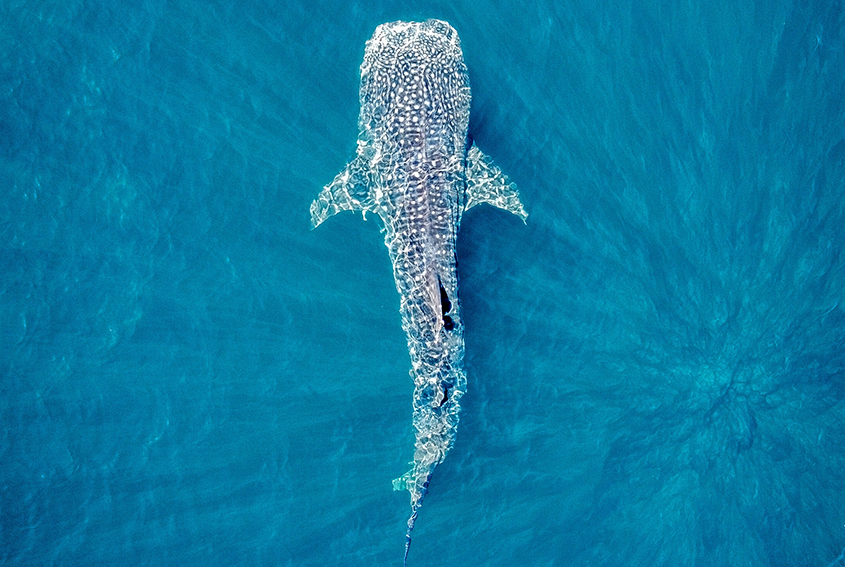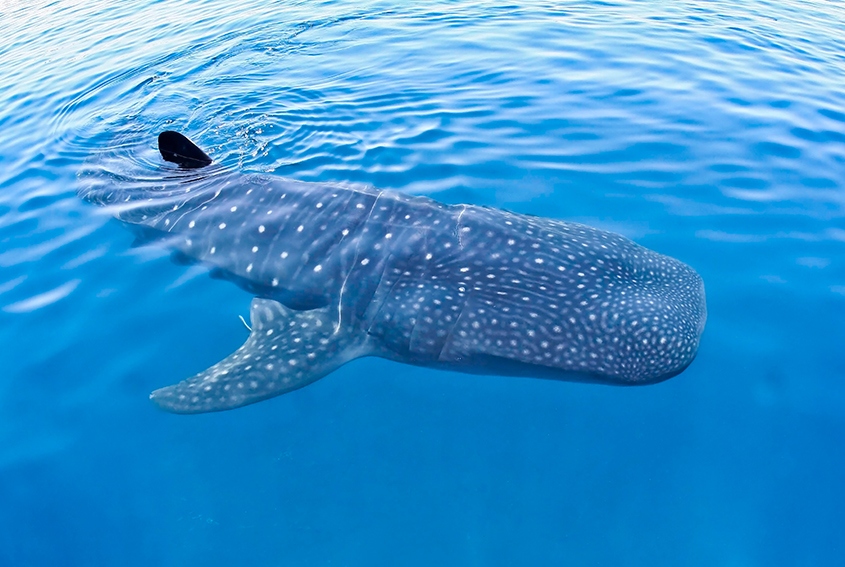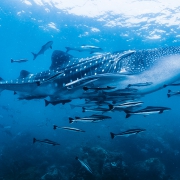This post is also available in:
![]() Spanish
Spanish

Swimming with the whale sharks, the gentle giants of the ocean is a Mexican Caribbean summer highlight and an amazing life experience. Small group guided eco tours are available from Cancun and are a must for nature lovers.
Watching BBC wildlife programs as a child always made me want to follow in the footsteps of Sir David Attenborough as he explored the natural world. Years of living in Mexico has given me the opportunity. Witnessing a female green turtle laying her eggs on a Riviera Maya beach as lightning flickered far out to sea was my first amazing wildlife sighting and there have been many more since. I have seen toucans, hummingbirds and flamingos; howler monkeys and scarlet macaws in the rain forests of Chiapas, wild dolphins, humpback and grey whales, and even the elusive jaguarundi, one of the five felines of the Yucatan. Yet, my most incredible experience to date has to be swimming with the whale sharks, the gentle giants of the ocean.
One calm, clear morning, I was on a boat heading for the zona azul or “blue water,” the name given to the deeper waters to the east of Contoy Island, scanning the surface of the ocean for signs of the pez domino or whale sharks that gather in this stretch of the Mexican Caribbean to feed on plankton during the summer months. Suddenly our guide spotted them, a flurry of fins everywhere and the shadows of the world’s largest fish looming out of the depths, the incredible sight of whale sharks surface feeding on plankton.
After watching several whale sharks glide past the boat, the guide said to me, “Get ready, when I say jump, jump.” During the two-hour boat ride to the whale shark feeding grounds, I had wondered whether I really would have the nerve to leap into the clear, but deep, water near a creature the size of a bus, but when the call came, I didn’t hesitate.
An immense shape appeared, my first whale shark; its gaping mouth open to scoop up the plankton and filter the water through its gills. I watched it swim past placidly, the blue-grey body dappled by sunlight, picking out the distinctive pattern of white spots and stripes that give it its nickname “domino fish.” Far from being daunted by its size, I felt a sensation of awe and tremendous peace as I gazed at it, the remora fish hitching a ride, and a cloud of tiny fish at work cleaning parasites from its skin. Then with one last flick of its tail it was gone, disappearing into the distance.
I emerged from the water elated and spluttering from the water I had swallowed during my incredible encounter. It was a moment that I’ll always treasure.

Why do whale sharks gather in the Mexican Caribbean?
Whale sharks migrate thousands of miles through the tropical oceans, moving between feeding grounds during the year. They gather in the Mexican Caribbean from mid-May to mid-September, when soaring summer temperatures cause rapid plankton growth and massive blooms of these microscopic creatures. Yet research studies in the Mexican Caribbean have also revealed that, in addition to plankton, whale sharks are partial to the eggs of a fish called the bonito or little tunny that also spawns during the summer. Biologists believe that the abundance of food triggers the largest whale shark gathering in the world. On one day in 2009, 420 of them were counted during a flight and in 2017, three groups of whale sharks were tracked, a total of 560 (source: Rafael de la Parra).
There are two whale shark feeding grounds: the area between the island of Holbox and Cabo Catoche, the headland where the Gulf of Mexico meets the Caribbean and upwellings of cold water from the deep rich in nutrients boost plankton growth, and the waters to the east of Contoy and Isla Mujeres. Due to the importance of this area for whale sharks and other marine species such as sailfish, marlin, manta rays, dolphins and sea turtles, the Mexican government declared it a marine biosphere reserve.
Sharing the same diet of plankton and fish eggs, manta rays mingle with the whale sharks and can sometimes be seen leaping from the water. Dolphins and sea turtles are often spotted on the way to the whale shark feeding grounds.

Wandering the oceans
Each whale shark has unique markings and taking photos of them is helping whale shark experts around the world to compile a catalog. Through the use of this international database for identification purposes, by tagging sharks and using satellite tracking they can now begin to map the movements of these enigmatic creatures. For example, they have been able to track whale sharks during the year as they swim through the Gulf of Mexico, the Mexican Caribbean and head south to Belize and the Bay Islands in Honduras. One female whale shark from the Gulf of Mexico population was even tracked to Brazil, earning her the name “Rio.”.
In the Indo-Pacific region, whale sharks gather off the Mozambique coast, the Maldives, Seychelles, Indonesia, Philippines, Australia, Fiji and the Sea of Cortez off Baja California Sur in Mexico.
Book the whale shark watching experience with Thomas More Travel to learn more about these beautiful creatures. Small group eco trips are available until mid-September.

